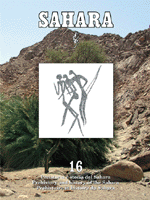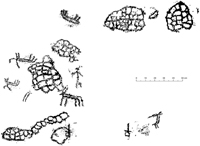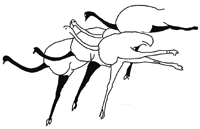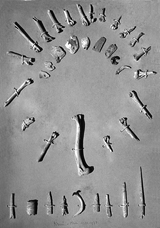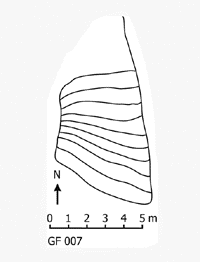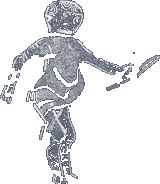 |
||||||||||||||||||||||||||||||||||
The study of a limestone fragment with complex engravings from Kef Zoura D rock shelter in Eastern Algeria is used to discuss Capsian and Neolithic representation systems for the illustration of the ostrich. Analysis of the engravings, using a combination of binocular microscopic observation and graphic treatment, makes it possible to follow the stages of incision and to detect at least three sets of engraved lines, the main one being associated with the representation of an ostrich. Today extinct in the Eastern Maghreb, this steppe animal formerly provided by its eggs an essential raw material for Capsian and Neolithic groups. Its roughly systematic absence in Capsian faunal assemblages suggests to some scholars that the ostrich was considered a sacred animal. The research reported here suggests that its representation in motion shows that the ostrich captivated prehistoric men just as it fascinates today the prehistorians who study it, and allows us to explore ideas about its place in the life and the imaginary thought of past groups. In spite of the slightly ambiguous context of discovery, comparative analysis with other Capsian and Neolithic engravings provides a firm suggestion for a chrono-cultural framework.
|
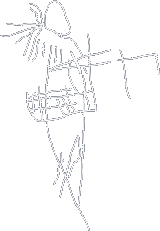
|
55 |
|
|||||||||||||||||||||||||||||||
|
|
Industries préhistoriques de la région de Fès (Maroc) La collection Charles Rivollier
During more than ten years, Charles Rivollier made prospections and excavations in the region of Fes (Morocco). His work was then unpublished and nothing was known about the industries he collected. In 1999, a train of circumstances allowed us to rediscover a part of the private collection in France, and numerous documents as well, that leads to a clear analysis and description of the lithic industries, ceramic and a very interesting collection of tools made of bone. Although precise dating is lacking, we felt as essential to publish this collection, a particularly rich contribution to the knowledge of a poorly prospected region. |
|||||||||||||||||||||||||||||||||
|
|
Nazca Lines in the Sudan? Gravel Features at the Fourth Nile Cataract
At the Fourth Nile Cataract (Sudan) a new barrage is under construction. The reservoir will have a length of 170 km along the river banks. During the 2003-2004 survey in the area endangered by inundation, 110 enigmatic man-made gravel features of different sizes and shapes have been found. They consist of lines and small clearings in the gravel ground showing similarities with the Peruvian Nazca lines. The main differences are the dimensions and the age (in Sudan they are smaller and perhaps not more than 100 years old) and the fact that with one single exception they do not show any real perceptible object or item. The gravel features are listed with their sizes and GPS positions. Examples are presented in drawings and photos. Their origin and purpose are discussed, but in fact the real and reasonable background of the phenomenon remains totally obscure. |
|||||||||||||||||||||||||||||||||
|
|
Images «Têtes rondes» dans l'art rupestre saharien: la piste animiste ABSTRACT
|
|||||||||||||||||||||||||||||||||
|
|
New rock art sites in the southwestern sector of Jebel Uweinat (Libya) ABSTRACT
|
|||||||||||||||||||||||||||||||||
Top
|
|
|||||||||||||||||||||||||||||||||
© Copyright 2000-2013 SAHARA - All rights reservedpostmaster@saharajournal.com |
||||||||||||||||||||||||||||||||||
Sahara 24 | Abstracts 24
Sahara 23 | Abstracts 23
Sahara 22 | Abstracts 22
Sahara 21 | Abstracts 21
Sahara 20 | Abstracts 20
Sahara 19 | Abstracts 19
Sahara 18 | Abstracts 18
Sahara 17 | Abstracts 17
Sahara 16 | Abstracts 16
Sahara 15 | Abstracts 15
Sahara 14 | Abstracts 14
Sahara 13 | Abstracts 13
Sahara 12 | Abstracts 12
Sahara 11 | Abstracts 11
Sahara 10 | Abstracts 10
Catalogue | Order form | Press
Home
Sahara 23 | Abstracts 23
Sahara 22 | Abstracts 22
Sahara 21 | Abstracts 21
Sahara 20 | Abstracts 20
Sahara 19 | Abstracts 19
Sahara 18 | Abstracts 18
Sahara 17 | Abstracts 17
Sahara 16 | Abstracts 16
Sahara 15 | Abstracts 15
Sahara 14 | Abstracts 14
Sahara 13 | Abstracts 13
Sahara 12 | Abstracts 12
Sahara 11 | Abstracts 11
Sahara 10 | Abstracts 10
Catalogue | Order form | Press
Home
